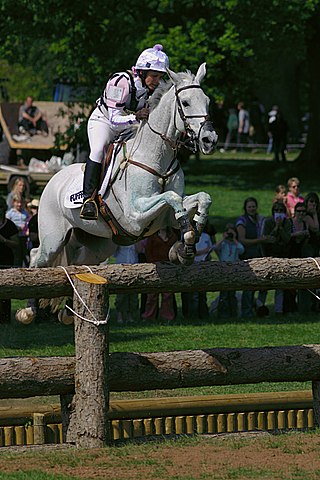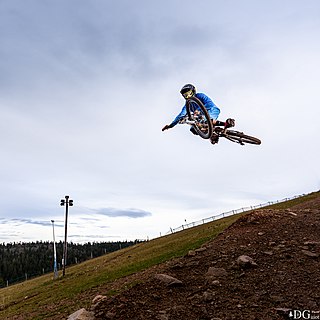
Trail riding is riding outdoors on trails, bridle paths, and forest roads, but not on roads regularly used by motorised traffic. A trail ride can be of any length, including a long distance, multi-day trip. It originated with horse riding, and in North America, the equestrian form is usually called "trail riding," or, less often "hacking." In the UK and Europe, the practice is usually called horse or pony trekking.
Show jumping is a part of a group of English riding equestrian events that also includes eventing, hunters, and equitation. Jumping classes are commonly seen at horse shows throughout the world, including the Olympics. Sometimes shows are limited exclusively to jumpers. Sometimes jumper classes are offered in conjunction with other English-style events. Sometimes, show jumping is but one division of a very large, all-breed competition that includes a very wide variety of disciplines. Jumping classes may be governed by various national horse show sanctioning organizations, such as the United States Equestrian Federation or the British Showjumping Association. International competitions are governed by the rules of the International Federation for Equestrian Sports.

Eventing is an equestrian event where a single horse and rider combine and compete against other competitors across the three disciplines of dressage, cross-country, and show jumping. This event has its roots in a comprehensive cavalry test that required mastery of several types of riding. The competition may be run as a one-day event (ODE), where all three events are completed in one day or a three-day event (3DE), which is more commonly now run over four days, with dressage on the first two days, followed by cross-country the next day and then show jumping in reverse order on the final day. Eventing was previously known as Combined Training, and the name persists in many smaller organizations. The term "Combined Training" is sometimes confused with the term "Combined Test", which refers to a combination of just two of the phases, most commonly dressage and show jumping.

Equestrianism, commonly known as horse riding or horseback riding, includes the disciplines of riding, driving, and vaulting. This broad description includes the use of horses for practical working purposes, transportation, recreational activities, artistic or cultural exercises, and competitive sport.

Bull riding is a rodeo sport that involves a rider getting on a bucking bull and attempting to stay mounted while the animal tries to buck off the rider.

Mountain biking is a sport of riding bicycles off-road, often over rough terrain, usually using specially designed mountain bikes. Mountain bikes share similarities with other bikes but incorporate features designed to enhance durability and performance in rough terrain, such as air or coil-sprung shocks used as suspension, larger and wider wheels and tires, stronger frame materials, and mechanically or hydraulically actuated disc brakes. Mountain biking can generally be broken down into five distinct categories: cross country, trail riding, all mountain, downhill, and freeride.

Cross country equestrian jumping is an endurance test that forms one of the three phases of the sport of eventing; it may also be a competition in its own right, known as hunter trials or simply "cross-country", although these tend to be lower-level, local competitions.

Equitation is the art or practice of horse riding or horsemanship.

Endurance riding is an equestrian sport based on controlled long-distance races. It is one of the international competitions recognized by the FEI. There are endurance rides worldwide. Endurance rides can be any distance, though they are rarely over 160 km for a one-day competition.

Freeride is a discipline of mountain biking closely related to downhill biking, dirt jumping, freestyle motocross, and freestyle BMX. When riding a freerider one focuses on tricks, style, and technical trail features. Freeride is now recognized as one of the most popular disciplines within mountain biking.

TREC, short for the French Techniques de Randonnée Équestre de Compétition is an equestrian discipline designed to test horse and rider. With origins in France, the sport has spread through Europe, and was introduced to the UK by the British Horse Society (BHS) in 1998. The sport is now known as British TREC and is run by TREC GB. TREC competitions consist of three separate events (phases) - mounted orienteering, a demonstration of control of the horse's paces and an obstacle course - all completed over the course of one or two days, and points scored, with the highest scoring being declared the overall event winner.

The Hunter division is a branch of horse show competition that is judged on the horse's performance, soundness and when indicated, conformation, suitability or manners. A "show hunter" is a horse that competes in this division.

Hunt seat is a style of forward seat riding commonly found in North American horse shows. Along with dressage, it is one of the two classic forms of English riding. The hunt seat is based on the tradition of fox hunting. Hunt seat competition in North America includes both flat and over fences for show hunters, which judge the horse's movement and form, and equitation classes, which judge the rider's ability both on the flat and over fences. The term hunt seat may also refer to any form of forward seat riding, including the kind seen in show jumping and eventing.

A slide is a skateboarding trick where the skateboarder slides sideways either on the deck or the trucks.

A bridle path, also bridleway, equestrian trail, horse riding path, ride, bridle road, or horse trail, is a trail or a thoroughfare that is used by people riding on horses. Trails originally created for use by horses often now serve a wider range of users, including equestrians, hikers, and cyclists. Such paths are either impassable for motorized vehicles, or vehicles are banned. The laws relating to allowable uses vary from country to country.

Western riding is considered a style of horse riding which has evolved from the ranching and welfare traditions which were brought to the Americas by the Spanish Conquistadors, as well as both equipment and riding style which evolved to meet the working needs of the cowboy in the American West. At the time, American cowboys had to work long hours in the saddle and often over rough terrain, sometimes having to rope a cattle using a lariat, also known as a lasso. Because of the necessity to control the horse with one hand and use a lariat with the other, western horses were trained to neck rein, that is, to change direction with light pressure of a rein against the horse's neck. Horses were also trained to exercise a certain degree of independence in using their natural instincts to follow the movements of a cow, thus a riding style developed that emphasized a deep, secure seat, and training methods encouraged a horse to be responsive on very light rein contact.

Steer riding is a rodeo youth event that is an introductory form of bull riding for younger riders, usually between the ages of seven and fourteen. Instead of bucking bulls, the children ride steers that buck. Steers are used because they are known to have a less volatile temperament than bulls and many breeds weigh less than bulls, which makes them a perfect stepping stone to junior bulls. The steers usually weigh between 500 to 1,000 pounds. Steer riding usually follows mutton busting and calf riding as the participant ages and grows. Many young and aspiring bull riders who train in steer riding compete in the National Junior Bullriders Association.
Trail is a competitive class at horse shows where horses and riders in western-style attire and horse tack navigate a series of obstacles. Contestants ride the course one at a time. Originally designed to resemble situations a horse and rider might actually encounter when on a trail in a natural habitat, modern trail classes now tend to focus more heavily on agility and manners, with courses bearing very little resemblance to real-world natural trails.
Various obstacles are found in competitive sports involving horse jumping. These include show jumping, hunter, and the cross-country phase of the equestrian discipline of eventing. The size and type of obstacles vary depending on the course and the level of the horse and rider, but all horses must successfully negotiate these obstacles in order to complete a competition. Fences used in hunter and eventing are generally made to look relatively rustic and natural.

Mountain bike trials, also known as observed trials, is a discipline of mountain biking in which the rider attempts to pass through an obstacle course without setting foot to ground. Derived from motorcycle trials, it originated in Catalonia, Spain as trialsín and is said to have been invented by Pere Pi, the father of Ot Pi, a world champion motorcycle trials rider. Pi's father had wanted his son to learn motorcycle trials by practicing on an ordinary bicycle.

















